Finetuning of the electromagnetic forces
https://reasonandscience.catsboard.com/t2856-finetuning-of-the-electromagnetic-forces
Fine-tuning of the electromagnetic forces, evidence of design?
https://www.youtube.com/watch?v=BhwCazIoVC4
The electromagnetic force, one of the four fundamental forces of nature, must be finely tuned in at least sixteen different ways, in order for life in our universe, and on earth, to be possible.
1. If the electromagnetic force was stronger than it is, some of the chemicals essential for life, like carbon and oxygen, would not bond together and other life-essential elements would be too unstable for fission to occur. If the electromagnetic force were weaker than it is, chemicals could not bond properly and there would be insufficient carbon and oxygen to support life.
2. The electromagnetic force needs to be much weaker than the strong nuclear force for atoms to be stable – so that the radius of the electron orbit is much larger than the radius of the nucleus The wavelengths of radio waves can vary from about one millimeter to about 100 kilometers, so they cover quite a wide range.
3. The electromagnetic radiation range produced by the sun must be precisely tuned to the energies of the various chemical bonds on Earth. Excessively energetic photons of radiation destroy chemical bonds and destabilize organic molecules.
4. Ratio of electromagnetic and gravitational forces: The value of N in astronomy is the ratio of the strength of the electromagnetic force to the gravitational force. N has the value approximately equal to 10^40, which is 10,000,000,000,000,000,000,000,000,000,000,000,000,000
5. A precise number of electrons must exist in the universe. Unless the number of electrons is equivalent to the number of protons to at least an accuracy of one part in 10^37, electromagnetic forces in the universe would have to overcome gravitational forces that galaxies, stars, and planets never would have formed. One part in 10^37 is such an incredibly sensitive balance that it is hard to visualize.
6. Electromagnetic repulsion between protons prevents most of their collisions from resulting in proton-proton fusion, this explaining how stars can burn so slowly: each second our sun generates thousands of times less energy per gram than the human body. The strength of electromagnetism by comparison with gravity is crucial here.
7. Matching the radiation from the sun to the chemical bonding energy requires that the magnitude of six constants be selected and finely adjusted, guaranteeing that the photons are sufficiently energetic, but not too energetic.
8. Atmospheric Transmittance: This is a plot of Earth’s atmospheric transmittance (or opacity) to various wavelengths of electromagnetic radiation. Most UV wavelengths are absorbed by oxygen and ozone in Earth’s atmosphere. Absorption of light by either Earth's atmosphere or by water where the necessary chemical reactions occur could render life on Earth impossible.
9. Strangely enough, the electromagnetic radiation of the sun is restricted to a tiny region of the total electromagnetic spectrum, equivalent to one card in a deck of 10^25, and that the very same infinitely minute region is precisely that required for life. In addition, both the atmospheric gases and water are opaque to all regions of the spectrum except this same tiny region. Denton concludes: "it is as if a card player had drawn precisely the same card on four occasions from a deck of 10^25"
10. There's a unique, non-dimensional atomic constant in physics known as “alpha” or the “electromagnetic fine structure constant” which underpins the whole of nature, the form and structure of the whole universe. It is better known by its reciprocal number which is essentially equivalent to 1/137.
11. The Balance of the Strong and Electromagnetic Forces must be just right. These two are the strongest of the four fundamental forces. Yet they are pitted against each other in the tiny world of the nucleus.
12. Stars produce carbon and oxygen in comparable amounts. Astrophysicists have recently confirmed the sensitivity of carbon and oxygen production to the carbon-energy resonance;
13. The Electromagnetic force coupling constant Universes with ordered structures occupy a tiny region. The red section is the tiny window where carbon-based life is possible.
14. Without a finely tuned electromagnetic force coupling constant, stars would be unable to produce elements beyond helium. There would be no carbon, oxygen, nitrogen, etc, required for life.
15. When we look at this part of the light we see that a large part of solar radiation falling outside the range of visible light is in the section of the spectrum called "near-infrared".
16. And the third part of sunlight? Is that of any benefit? You can bet on it. This is "near-ultraviolet light" and it makes up the smallest fraction of sunlight.
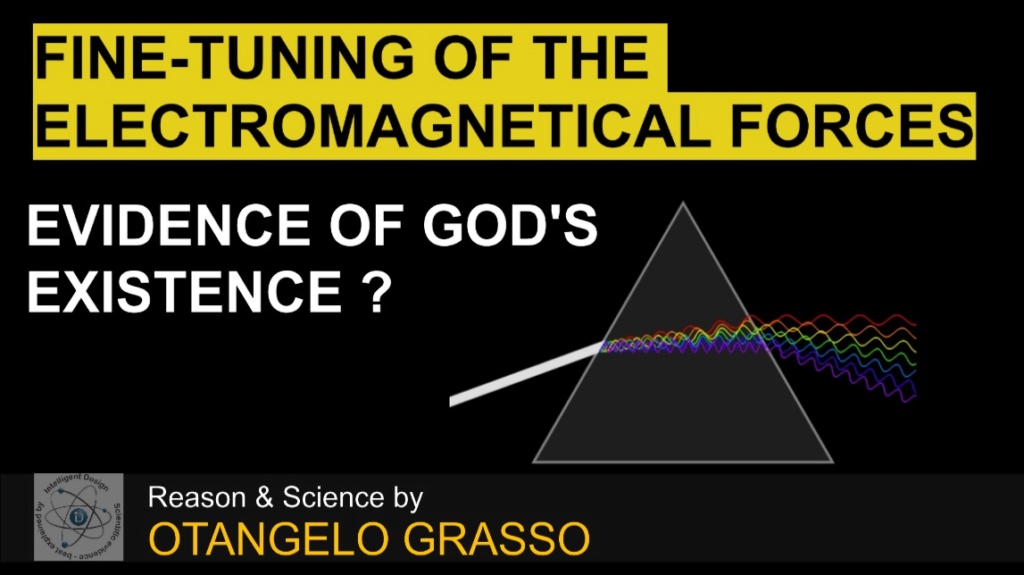

Nobody in 1800 could have imagined that, within a hundred years or so, people would live in cities illuminated by electric light, work with machinery driven by electricity, in factories cooled by electric-powered refrigeration, and go home to listen to a radio and talk to neighbours on a telephone.
Remarkably, the scientists that made the milestone discoveries and advanced scientific knowledge in the field of electricity and electromagnetism were almost all devout Christians. They will be presented at this video, together with their inventions.
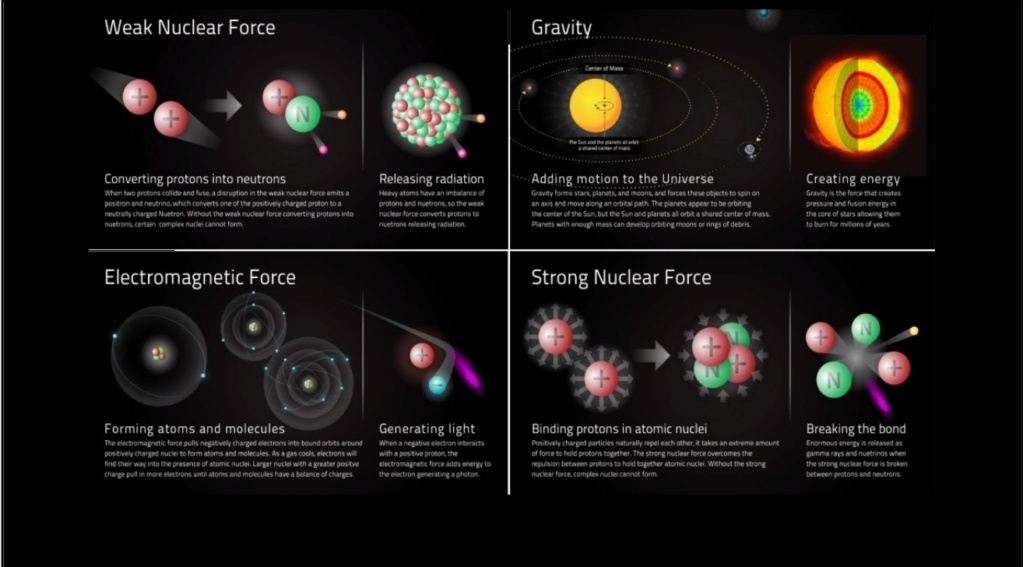
Everybody knows the practical use of electricity in modern life. The electromagnetic force underlying it belongs to the four fundamental forces
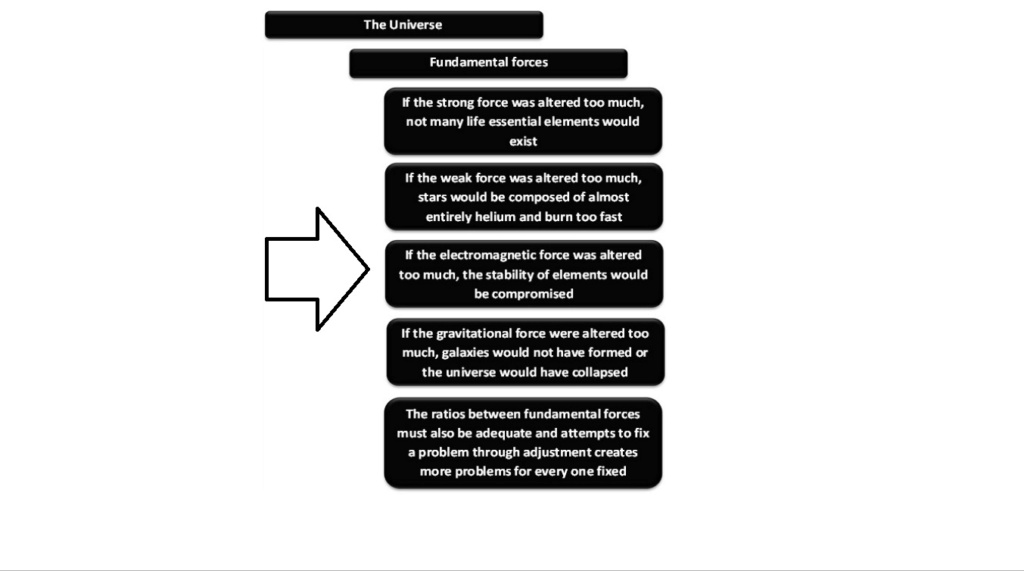
and must be finely tuned also in relation to other fundamental forces, to make a life-permitting universe possible. In this video, we will furthermore give a closer look at how the electromagnetic force must be finely tuned in various ways.

William Gilbert was the first man to research the properties of the lodestone (magnetic iron ore), publishing his findings in his influential book in 1600, 'De Magnete' ('The Magnet'). He actually coined the Latin word electricitas, which in English became electricity. He was besides Galileo the great pioneer of modern science.

The impact of Gilberts finding is eminent. He was one of the first modern scientists, also the accredited father of the science of electricity and magnetism, an Englishman of learning. In 1601, he was appointed as one of Queen Elizabeth’s personal physicians.
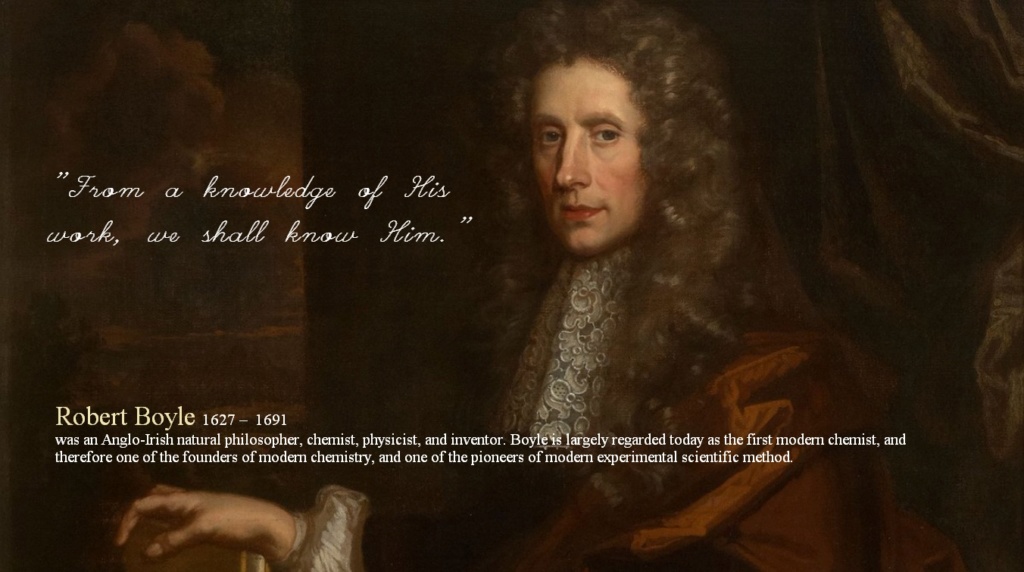
Gilbert's work was followed up by Robert Boyle, the famous natural philosopher who was once described as "father of Chemistry." Boyle was also one of the founders of the Royal Society. Boyle is known for his exceptional scientific work, that produced some fundamental discoveries.
He worked frequently at the new science of electricity and added several substances to Gilbert's list of electrics. He left a detailed account of his researches under the title of Experiments on the Origin of Electricity. He was a devout and pious Anglican and is noted for his writings in theology.
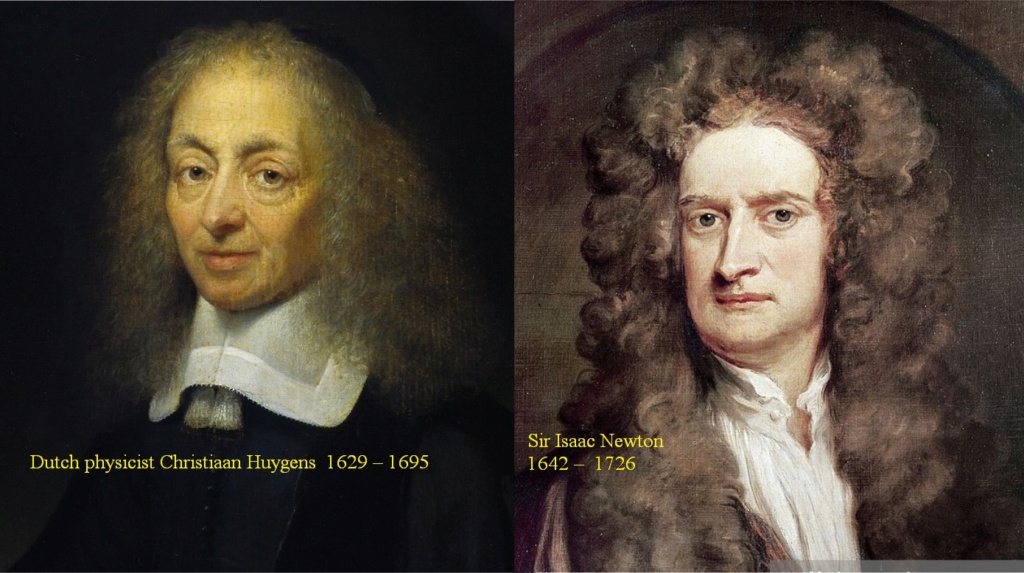
“What is light?” is a question that has intrigued scientists for centuries. In 1675, the famous English scientist Isaac Newton proposed that light was a stream of tiny particles. His rival, the Dutch physicist Christiaan Huygens, suggested that light consisted of waves, but Newton’s theories often dominated, partly due to Newton’s prestige.
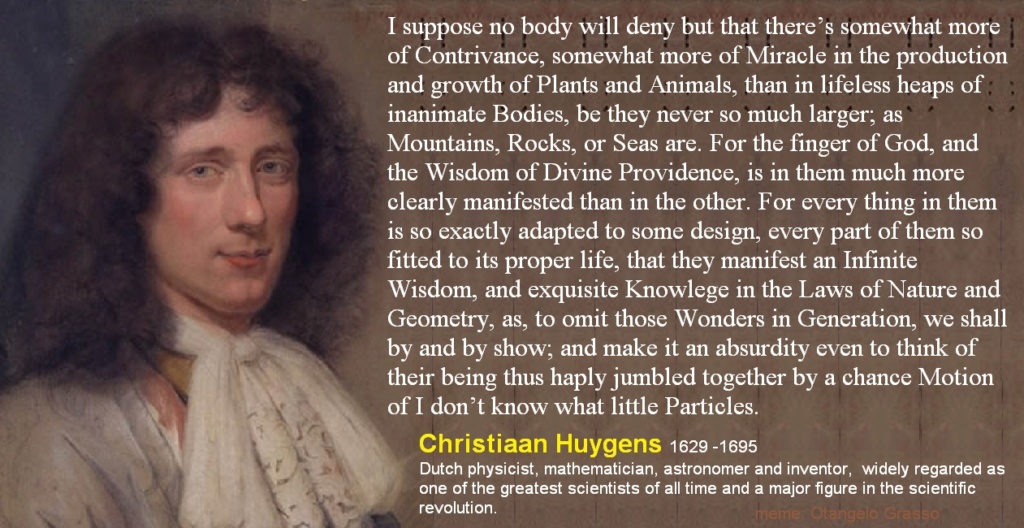
Christiaan Huygens is today less known than Newton, nonetheless, he can be considered one of the greatest scientific geniuses of the 17th century, and if he lived today, he would be known as a promiment “intelligent design” promoter.
In the picture above is a quote from his book Cosmotheoros from 1698. If it were stated in modern English today, it would anger many origin-of-life researchers and evolutionary biologists. They would undoubtedly attribute it to one of the leaders of the intelligent design movement.
This was stated by the man who invented the pendulum clock, wrote the first book on probability, described the wave theory of light mathematically, belonged to the Royal Society and the French Academy of Sciences, accurately described Saturn’s rings as not touching the planet and discovered Saturn’s large moon Titan.
He also stood in the tradition seen so often in the scientists in this series that viewed scientific investigation as an honourable work undertaken “for the glory of God and the service of man.”

Around 1800, the English researcher Thomas Young—also famous for his work on deciphering the Rosetta Stone—began a series of experiments that provided support for Huygens’ wave theory.

In 1801,he made a famous double-slit experiment, which clearly showed that light diffracted, and therefore must travel in the form of a wave. Young used geometrical arguments to show that the superposition of light waves from the two slits explains the observed series of equally spaced bands (fringes) of light and dark regions, representing constructive and destructive interference, respectively.
Thomas Young was one of those rare individuals with such awesome intellectual powers it makes one marvel at the potential in one human brain. And if one thinks intelligence leads to skepticism, Young would disagree. He maintained his childlike faith and moral uprightness throughout his all-to-brief life of 56 years.
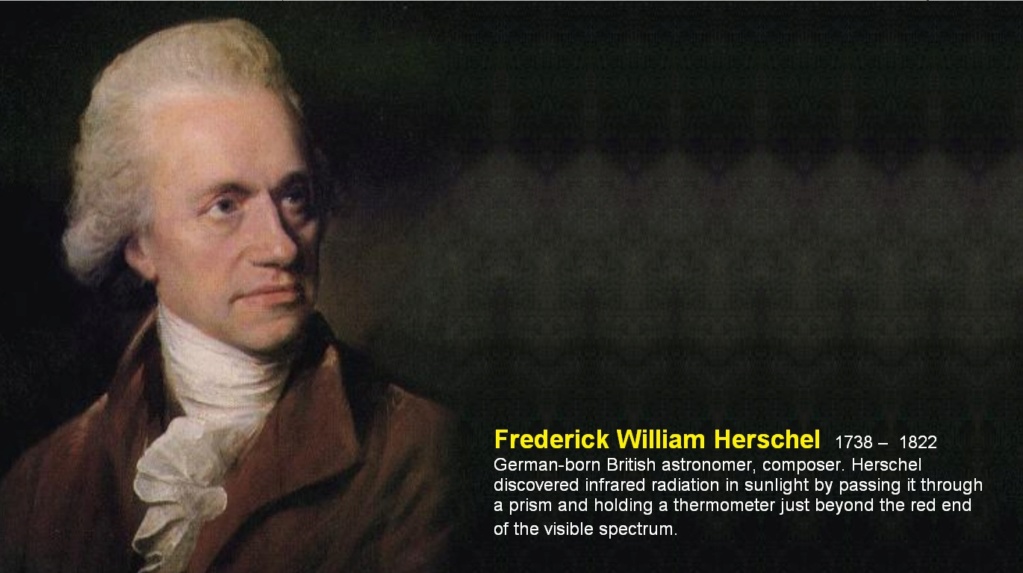
In 1800, William Herschel used a prism and a thermometer to measure the temperature of coloured light. He discovered that red light was warmer than violet light at the other end of the visible spectrum. He also noticed that there was measurable warmth beyond red light, even though no visible light was present. He had discovered the infra-red part of the electromagnetic spectrum.
William Herschel constructed over 400 telescopes, including the largest reflecting telescopes of his day, using them to catalog over 90,000 new stars, as well as nebulae and galaxies. After discovering Uranus, the 7th planet from the sun, King George III granted William Herschel a permanent salary as a royal astronomer. He believed in a divine Creator and Author of the laws of nature, to whom we owe our worship and admiration.

By 1825, French physicist André-Marie Ampère had established the foundation of electromagnetic theory. The connection between electricity and magnetism was largely unknown until 1820, when it was discovered that a compass needle moves when an electric current is switched on or off in a nearby wire.
Although not fully understood at the time, this simple demonstration suggested that electricity and magnetism were related phenomena, a finding that led to various applications of electromagnetism and eventually culminated in telegraphs, radios, TVs, and computers.
Subsequent experiments during a period from 1820 to 1825 by Ampère and others showed that any conductor that carries an electric current and produces a magnetic field around it. This basic finding and its various consequences for conducting wires is sometimes referred to as Ampère’s Law of Electromagnetism.
Maxwell wrote about Ampère's achievements:
The experimental investigation by which Ampere established the law of the mechanical action between electric currents is one of the most brilliant achievements in science. The whole theory and experiment seems as if it had leaped, full grown and full armed, from the brain of the 'Newton of Electricity'.
It is perfect in form, and unassailable in accuracy, and it is summed up in a formula from which all the phenomena may be deduced, and which must always remain the cardinal formula of electro-dynamics.
In 1804, Ampère helped to form a group called the Société Chrétienne (Christian Society). Each member was a scholar, and each was given the task of producing a statement about the Christian faith. Ampère was tasked with writing about rational evidence that supports Christianity. According to his biographer, he wrote:

All modes of proof combine in favour of Christianity. To see the truth, the metaphysician needs only to examine the manner in which the divine religion simultaneously explains the grandeur and the baseness of man, and the idea it gives us of the relations of God with his creatures and of the intentions of Providence.
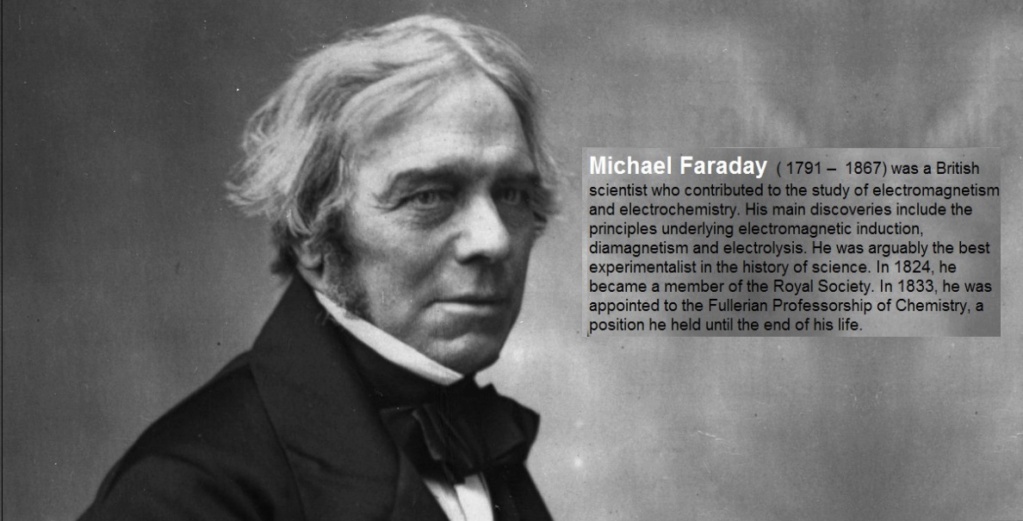
In 1831, Michael Faraday discovered electromagnetic induction, which was his greatest contribution to science. He noticed that when he moved a magnet through a stationary coil of wire, he always produced an electric current in the wire.

Faraday believed that God sustained the universe and that he was doing God’s will to reveal truth through careful experiments and through his colleagues, who tested and built upon his results.

He accepted every word of the Bible as literal truth, but meticulous experiments were essential in this world before any other kind of assertion could be accepted.

James Clerk Maxwell developed in a series of papers in 1861 and 1862 a single theory of electricity and magnetism that was able to explain all of the experimental work of Faraday, Ampère and others.

But Maxwell’s crowning glory came in 1864 when he published a paper that is undoubtedly one of the greatest achievements in the history of science. The speed of the waves is the ratio of the strengths of the electric and magnetic fields – quantities that had been measured by Faraday, Ampère, and others and were well known to Maxwell.
His calculations unravelled that light is composed of electromagnetic waves, a theory that was proved to be correct by H. Hertz in 1887, who also detected electromagnetic waves with very long wavelengths and thus added the radio band to the electromagnetic spectrum.

When Maxwell did the sums, he must have fallen off his chair. He found that his equations predicted that the waves in the electric and magnetic fields traveled at the speed of light! Maxwell's equations for electromagnetism have been called the "second great unification in physics" after the first one realised by Isaac Newton.

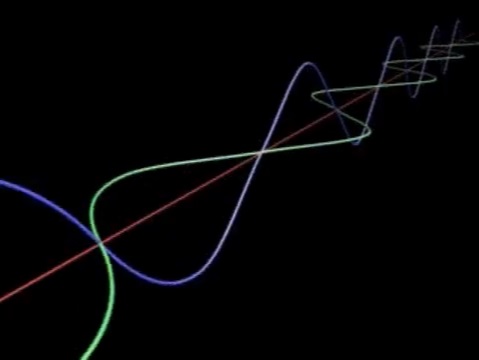
In other words, Maxwell had discovered that light is nothing more than oscillating electric and magnetic fields, sloshing back and forth and propelling each other through space as they do so. How beautiful that the work of Faraday, Ampère, and others with coils of wire and pieces of magnets could lead to such a profound conclusion through the use of a bit of mathematics and a sprinkling of Scottish genius! In modern language, we would say that light is an electromagnetic wave.
Albert Einstein later described Maxwell’s 1860s papers as ‘the most profound and the most fruitful that physics has experienced since the time of Newton.’ Maxwell discovered that by unifying electrical and magnetic phenomena together into a single mathematical theory, a startling prediction emerges. Electricity and magnetism can be unified by introducing two new concepts: electric and magnetic fields.

The concept of a field is central to modern physics; the temperature in a room can be represented as a field. If we measure the temperature at each point in the room and note it down, we would have a vast array of numbers that described how the temperature changes from the door to the windows and from the floor to the ceiling.

In a similar way, we can use the concept of a magnetic field by holding a compass at places around a wire carrying an electric current and noting down how much the needle changes its direction. The numbers and directions are the magnetic fields. Maxwell discovered that by introducing the electric and magnetic fields and placing them centre stage, he was able to write down a single set of equations that described all the known electrical and magnetic phenomena.
He mathematically disproved the nebular hypothesis proposed in 1796 by French atheist, Laplace, which suggested that the solar system began as a cloud of gas which contracted to produce stars and planets. Maxwell also strongly opposed Darwin’s theory of evolution, which was becoming popular at that time.
He believed that the speculations involved in evolutionary thinking contradicted scientific evidence. Maxwell was convinced that scientific investigation and the teachings of the Bible were not only compatible but should be linked together.
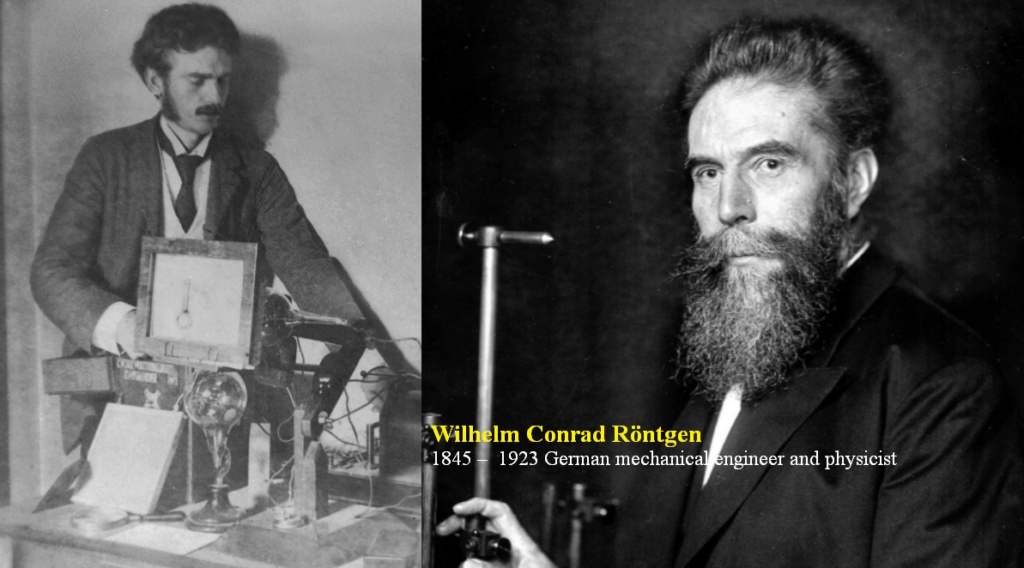
In another milestone in 1895, Wilhelm Conrad Röntgen was the first person to systematically produce and detect electromagnetic radiation in a wavelength range today known as x-rays. He produced and detected electromagnetic radiation, an achievement that earned him the first Nobel Prize in Physics in 1901. Max von Laue finally demonstrated that these X-rays are electromagnetic waves of extremely short wavelengths.
By then the wavelength range of the electromagnetic spectrum spanned from about 1 nanometer to 100 meters.
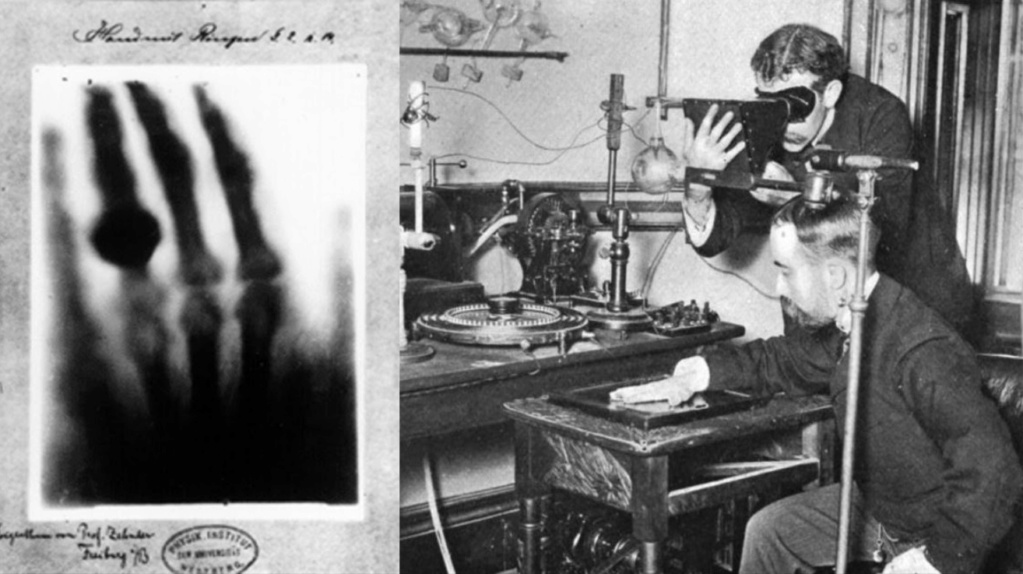
Röntgen was conducting experiments with electrical discharges in evacuated glass tubes. One night, he noticed a glow which was not caused by fluorescence or visible light. He named this discovery "X." When he immobilised for some moments in one of his experiments the hand of his wife in the path of the rays over a photographic plate, he observed after development of the plate an image of his wife’s hand. This was the first “röntgenogram” ever taken.

Wilhelm Conrad Röntgen and his father were members of the Dutch Reformed Church, the mainstream Protestant congregation in the Netherlands, also the religion of the Dutch royal family. Röntgen’s mother, however, belonged to the much smaller Wallonian Protestant Church which since 1815 is a division of the Dutch Reformed Church. French was the language of their worship services.

The induction motor is one of the most important inventions in modern history. It turned the wheels of progress at a new speed and officially kicked off the second industrial revolution by drastically improving energy generation efficiency and making the long-distance distribution of electricity possible.

Today, not only do the machines turn on the lights in your home but also power many mechanical gadgets people take for granted, from vacuum cleaners and electric toothbrushes to that classy Tesla Motors Model S.
The electromagnetic spectrum, fine-tuned for life
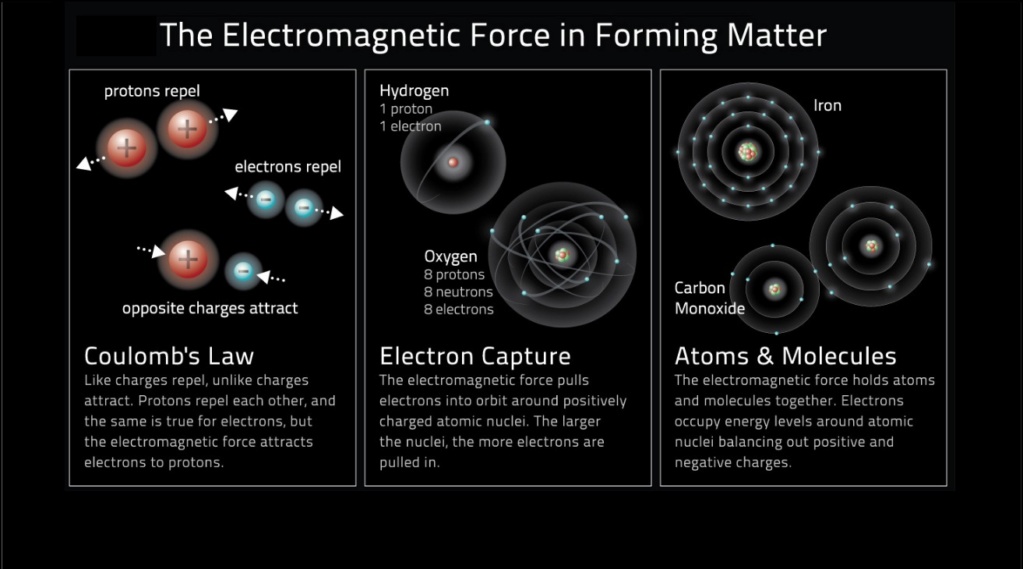
Electrons are held in their orbit by the electromagnetic force. Electrons have a negative electric charge and are therefore attracted to the protons which have a positive electric charge.
The two fundamental forces of gravity and electromagnetism need to be balanced on razor'srs edge, and the radiation of the sun has to be finely tuned to permit life on earth.

The electromagnetic force is responsible for holding electrons in their orbit around the nucleus of an atom. These electrons interact with other electrons to form electron bonds among elements and produce molecules and, eventually, visible matter. Electrons give atoms the ability to link to each other to form bonds which create molecules, which are the building blocks of matter.
Without these bonds, matter would cease to exist beyond the atomic level.
Imagine a Universe Creating Machine with numerous dials, each of which sets the value of a fundamental law, constant, or initial condition. Only if each of the dials is set to the right combination will the machine produce a habitable universe. Most of the settings produce uninhabitable universes.
1. If the electromagnetic force was stronger than it is, some of the chemicals essential for life, like carbon and oxygen, would not bond together and other life-essential elements would be too unstable for fission to occur. If the electromagnetic force were weaker than it is, chemicals could not bond properly and there would be insufficient carbon and oxygen to support life.
2. The electromagnetic force needs to be much weaker than the strong nuclear force for atoms to be stable – so that the radius of the electron orbit is much larger than the radius of the nucleus The wavelengths of radio waves can vary from about one millimeter to about 100 kilometers, so they cover quite a wide range.

At the beginning of the twentieth century Max Planck and Albert Einstein, two Nobel Prize winners, carried out the epoch-making studies proving that light has a dual nature.
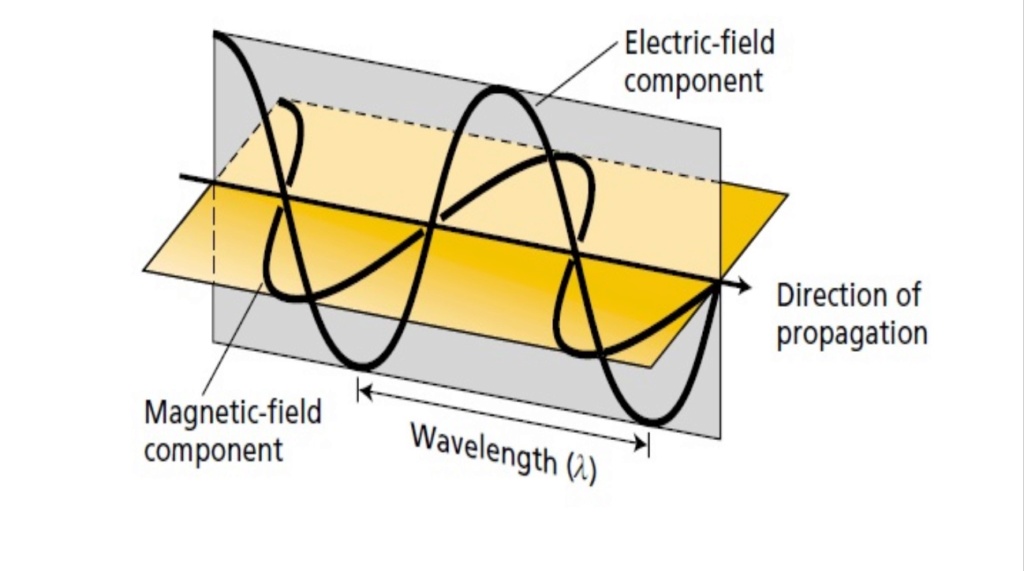
It can be regarded as an electromagnetic wave as well as an emission of particles, which are termed light quanta or photons. Light has properties of waves.


The electromagnetic spectrum refers to the vast range of frequencies of electromagnetic radiation. It is composed of waves of energy that can propagate through a vacuum and that contain electric and magnetic field components that oscillate perpendicular to each other. Different portions of the spectrum are identified according to the frequency of the waves.
In order of increasing frequency (and decreasing wavelength), we have radio waves, microwaves, infrared radiation, visible light, ultraviolet radiation, Xrays, and gamma rays. A specific "colour" of light has a characteristic wavelength. The distance between peaks in a wave is referred to as the wavelength and is abbreviated with the Greek letter lambda.

The longer the wavelength, the less energy it carries. The shorter the wavelength the more energy is associated with that band of the electromagnetic spectrum.

3. The electromagnetic radiation range produced by the sun must be precisely tuned to the energies of the various chemical bonds on Earth. Excessively energetic photons of radiation destroy chemical bonds and destabilize organic molecules.
Insufficiently energetic photons would result in chemical reactions that are either too sluggish or would not occur at all. All life on Earth depends upon fine-tuned solar radiation, which requires, in turn, a very precise balancing of the electromagnetic and gravitational forces.
Happily, our star (the sun) emits radiation (light) that is finely tuned to drive the chemical reactions necessary for life. But there is still a critical potential problem: getting that radiation from the sun to the place where the chemical reactions occur. Passing through the near vacuum of space is no problem.

John A. Leslie: A star’s surface temperature must be suitably related to the binding energies of chemical reactions used by organisms: it must be hot enough to encourage construction of new chemicals, as in photosynthesis, but also cool enough to limit destruction such as is produced by ultraviolet light.

4. Ratio of electromagnetic and gravitational forces: The value of N in astronomy is the ratio of the strength of the electromagnetic force to the gravitational force. N has the value approximately equal to 10^40, which is 10,000,000,000,000,000,000,000,000,000,000,000,000,000
The force of gravity is a thousand million billion billion billion times weaker than the electromagnetic force. To guard against any one disaster by tinkering with these or those factors would be likely only to introduce some new disaster because each factor enters into so many vital relationships.
If the electromagnetic force were to be even slightly stronger relative to all the other fundamental forces, all stars would be red dwarfs, and planets would not form. Or if it were a little weaker, all stars would be very hot, and thus short-lived.
Gravity as one of these forces also needs fine tuning for stars and planets to form, and for stars to burn stably over billions of years. Gravity is roughly 10^39 times weaker than electromagnetism. Had it been only 10^33 times weaker, stars would be a billion times less massive and would burn a million times faster.
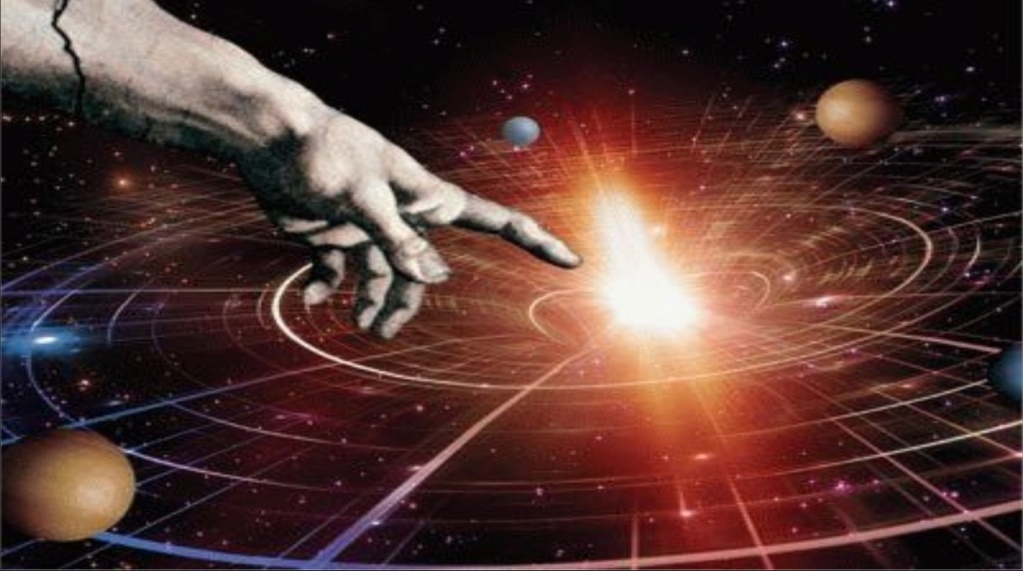
5. A precise number of electrons must exist in the universe. Unless the number of electrons is equivalent to the number of protons to at least an accuracy of one part in 10^37, electromagnetic forces in the universe would have to overcome
gravitational forces that galaxies, stars, and planets never would have formed. One part in 10^37 is such an incredibly sensitive balance that it is hard to visualize. The following analogy given by Hugh Ross might help:
Cover the entire North American continent in dimes all the way up to the moon, a height of about 239,000 miles. (In comparison, the money to pay for the U.S. federal government debt would cover one square mile less than two feet deep with dimes.) Next, pile dimes from here to the moon on a million other continents the same size as North America.
Paint one dime red and mix it into the billion piles of dimes. Blindfold a friend and ask him to pick out one dime. The odds that he will pick the red dime are one in 10^37. And this is only one of the parameters that is so delicately balanced to allow life to form.
6. Electromagnetic repulsion between protons prevents most of their collisions from resulting in proton-proton fusion, this explaining how stars can burn so slowly: each second our sun generates thousands of times less energy per
gram than the human body. The strength of electromagnetism by comparison with gravity is crucial here.

7. Matching the radiation from the sun to the chemical bonding energy requires that the magnitude of six constants be selected and finely adjusted, guaranteeing that the photons are sufficiently energetic, but not too energetic.
In what is either an amazing coincidence or careful design by an intelligent Creator, these constants have the very precise values relative to each other that are necessary to give a universe in which radiation from the sun is tuned to the necessary chemical reactions that are essential for life. The greatest intensity of radiation from the sun occurs at the place of greatest biological utility.

8. Atmospheric Transmittance: This is a plot of Earth’s atmospheric transmittance (or opacity) to various wavelengths of electromagnetic radiation. Most UV wavelengths are absorbed by oxygen and ozone in Earth’s atmosphere. Absorption of light by either Earth's atmosphere or by water where the necessary chemical reactions occur could render life on Earth impossible.
It is remarkable that both the Earth's atmosphere and water have "optical windows" that allow visible light (just the radiation necessary for life) to pass through with very little absorption, whereas shorter wavelength (destructive ultraviolet radiation) and longer wavelength (infrared) radiation are both highly absorbed
It is remarkable that the optical properties of water and our atmosphere, the chemical bonding energies of the chemicals of life, and the radiation from the sun are all precisely harmonized to allow living systems to utilize the energy from the sun, without which life could not exist.
The British physicist Ian Campbell addresses this question and says "That the radiation from the Sun (and from many sequence stars) should be concentrated into a minuscule band of the electromagnetic spectrum which provides precisely the radiation required to maintain life on earth is very remarkable." According to Campbell, this situation is "staggering".
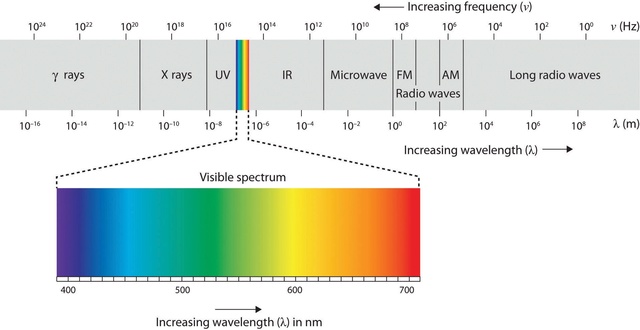
9. Nearly all of the Sun's radiation is restricted to a narrow band of wavelengths ranging from 0.3 to 1.50 microns. This band encompasses near ultraviolet, visible, and infrared light. In the whole electromagnetic spectrum, there is just one little band that has the energy to cross this threshold exactly. Its wavelengths range between 0.70 microns and 0.40 microns and if you'd like to see it, you can: just raise your head and look around–it's called "visible light".
This radiation causes chemical reactions to take place in your eyes and that is why you are able to see. Visible light covers the range of wavelengths from 400 - 700 nm. Our sun emits most of its radiation in the visible range, which our eyes perceive as the colours of the rainbow. Our eyes are sensitive only to this small portion of the electromagnetic spectrum.
Some wavelengths are several kilometers long while others are shorter than a billionth of a centimeter and the other wavelengths are to be found in a smooth, unbroken spectrum everywhere in between. To make things easier, scientists divide this spectrum up according to wavelength and they assign different names to different parts of it. The radiation with the shortest wavelength (one-trillionth of a centimeter) for example is called "gamma rays": these rays pack tremendous amounts of energy. The longest wavelengths are called "radio waves": they can be several kilometers long but carry very little energy.
Strangely enough, the electromagnetic radiation of the sun is restricted to a tiny region of the total electromagnetic spectrum, equivalent to one card in a deck of 10^25, and that the very same infinitely minute region is precisely that required for life. In addition, both the atmospheric gases and water are opaque to all regions of the spectrum except this same tiny region. Denton concludes: "it is as if a card player had drawn precisely the same card on four occasions from a deck of 10^25"

The number of electrons to protons must be finely balanced to a degree of one part in 10^37. If this fundamental constant were to be any larger or smaller than this, the electromagnetism would dominate gravity -- preventing the formation of galaxies, stars and planets. Again, life would not be possible.

The ratio of the electromagnetic force to gravity must be finely balanced to a degree of one part in 10^40. If this value were to be increased slightly, all stars would be at least 40% more massive than our Sun. This would mean that stellar burning would be too brief and too uneven to support complex life. If this value were to be decreased slightly, all stars would be at least 20% less massive than the sun. This would render them incapable of producing heavy elements.
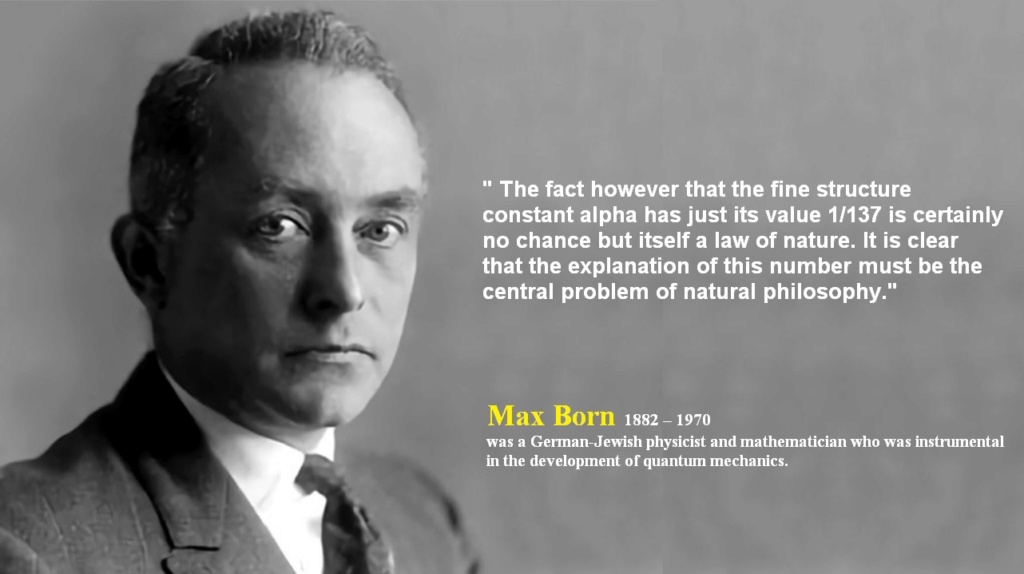
10. There's a unique, non-dimensional atomic constant in physics known as “alpha” or the “electromagnetic fine structure constant” which underpins the whole of nature, the form and structure of the whole universe. It is better known by its reciprocal number which is essentially equivalent to 1/137.

It is related to the probability of electrons or other charged particles absorbing or emitting photons and is the ratio of the strength of electromagnetism compared to the strong nuclear force. Increasing it to above 1/85 (from its present 1/137) could result in too many proton decays for there to be long-lived stars, let alone living beings who were not killed by their own radioactivity.
The number is required to know how specific wavelengths of light interact in precise ways with atoms and how electromagnetic forces hold atoms together. Hence we know that this number is one of the core factors that determine the size of the atoms.
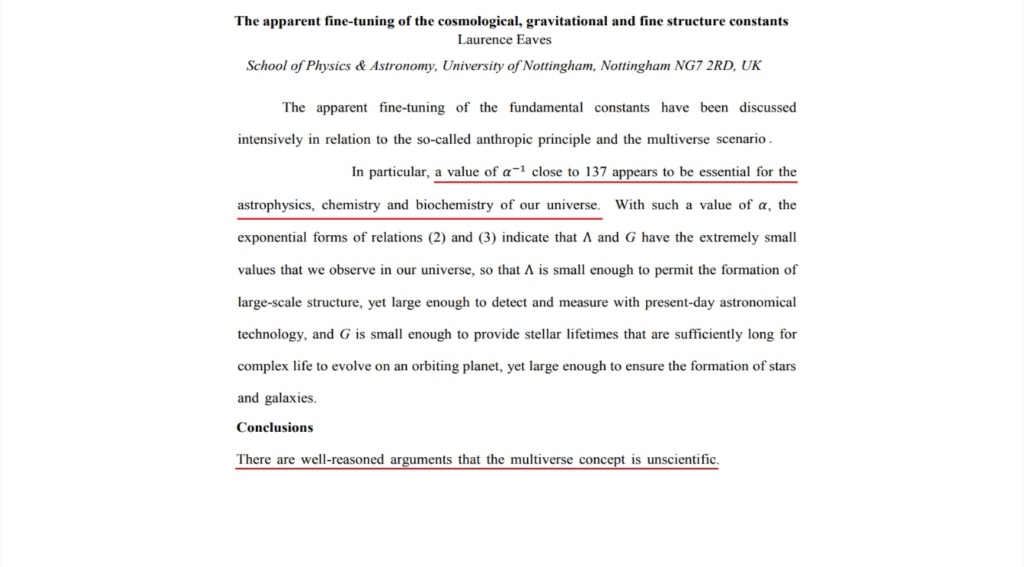
The fine-structure constant controls how strong chemical bonds are, how we see light and the vast majority of the things in the world. It also controls fusion in stars, which is important as that’s how all the chemical elements are created. It governs—among other things—the energy levels of an atom formed from negatively charged electrons and a positive nucleus.

American theoretical physicist Feynman once commented on the famous value of the fine structure constant alpha :

“There is a most profound and beautiful question associated with the observed coupling constant, e—the amplitude for a real electron to emit or absorb a real photon . . . It’s one of the greatest damn mysteries of physics: a magic number that comes to us with no understanding by man. You might say the ‘hand of God’ wrote that number, and ‘we don’t know how He pushed his pencil’.
J.D.Barrow and F.J.Tipler remark that in any case the difference between material things and waves is maintained only thanks to the smallness of the electromagnetic fine structure constant: it has to be a small fraction—it is about 1/137—to ensure ‘the distinguishability of matter and radiation’, for reasons centred on how an electron might be thought of as spending that same fraction of its time ‘as an electromagnetic wave’. Had the fraction been much larger, atomic and molecular states would be very unstable.

11. The Balance of the Strong and Electromagnetic Forces must be just right. These two are the strongest of the four fundamental forces. Yet they are pitted against each other in the tiny world of the nucleus. The balance in atomic nuclei between strong-force attraction and the electromagnetic repulsion which nearly blows apart any atom with two protons or more must be precisely tuned.
Together with the Pauli principle, the small mass of the electron, the fact that electrons do not feel the strong force, this balance allows for a hundred or so markedly different kinds of atom: building-bricks whose electrons make them more useful than the solid spheres imagined by an early physics.
12. Stars produce carbon and oxygen in comparable amounts. Astrophysicists have recently confirmed the sensitivity of carbon and oxygen production to the carbon-energy resonance; a change in the (strong) nuclear force strength (the force that binds particles in an atomic nucleus) by more than about half a percent, or by 4 percent in the electromagnetic force (the force between charged particles), would yield a universe with either too much carbon compared with oxygen or vice versa, and thus little if any chance for life.

13. The Electromagnetic force coupling constant Universes with ordered structures occupy a tiny region. The red section is the tiny window where carbon-based life is possible. We can see, how the electromagnetic force, more precisely, the electromagnetic coupling constant, also called the fine structure constant, plays a decisive role.
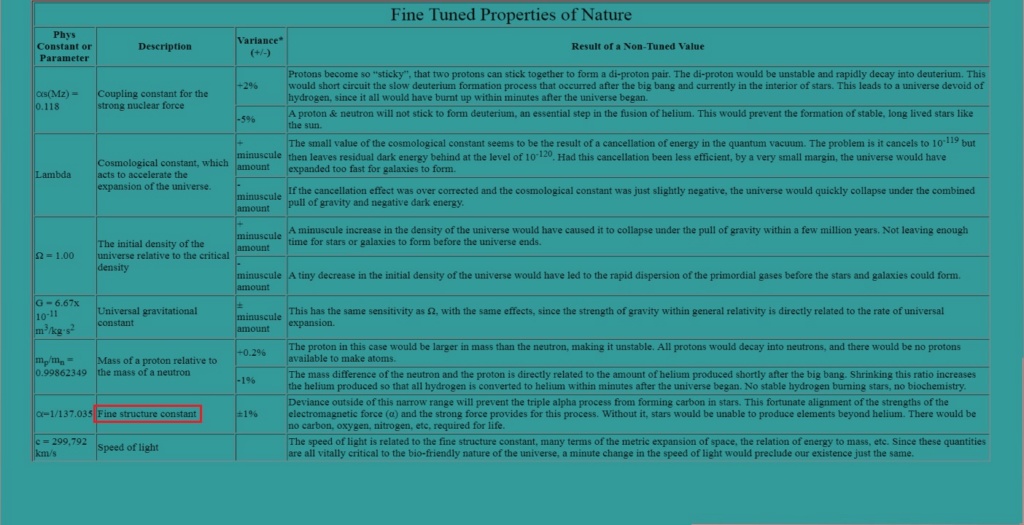
14. Without a finely tuned electromagnetic force coupling constant, stars would be unable to produce elements beyond helium. There would be no carbon, oxygen, nitrogen, etc, required for life.
Furthermore, the electromagnetic coupling constant binds electrons to protons in atoms. If it was smaller, fewer electrons could be held. If it was larger, electrons would be held too tightly to bond with other atoms.

15. When we look at this part of the light we see that a large part of solar radiation falling outside the range of visible light is in the section of the spectrum called "near infrared". This begins where visible light ends and again occupies a very small part of the total spectrum–less than 1/10^25 Is infrared light good for anything?
Yes, but this time it's no use to look around because you can't see it with the naked eye. However, you can easily feel it: the warmth you feel on your face when you look up on a bright sunny summer or spring day is caused by infrared radiation coming from the Sun. The Sun's infrared radiation is what carries the thermal energy that keeps Earth warm.
It too is as essential for life as visible light is. And the fascinating thing is that our Sun was apparently created just to serve for these two purposes because these two kinds of light make up the greatest part of sunlight.
16. And the third part of sunlight? Is that of any benefit? You can bet on it. This is "near ultraviolet light" and it makes up the smallest fraction of sunlight. Like all ultraviolet light, it is highly energized and it can cause damage to living cells. The Sun's ultraviolet light, however, is the "least harmful" kind since it is closest to visible light.
Although overexposure to solar ultraviolet light has been shown to cause cancer and cellular mutations, it has one vital benefit: the ultraviolet light concentrated in such a minuscule band is needed for the synthesis of vitamin D in humans and other vertebrates.
(Vitamin D is necessary for the formation and nourishment of bone: without it, bones become soft or malformed, a disease called rickets that occurs in people deprived of sunlight for great lengths of time.) In other words, all the radiation emitted by the Sun is essential to life: none of it is wasted.
The amazing thing is that all this radiation is limited to a 1/10^25 interval of the whole electromagnetic spectrum yet it is sufficient to keep us warm, see, and allow all the chemical reactions necessary for life to take place. Even if all the other conditions necessary for life, if the light radiated by the Sun fell into any other part of the electromagnetic spectrum, there could be no life on Earth.
It is certainly impossible to explain the fulfilment of this condition having a probability of 1 in 10^25 with a logic of coincidence. And if all this were not enough, light does something else: it keeps us fed, too!

The Christian doctrine of creation gave the impetus to scientific discovery in Western Christendom in the first place because it said that the universe was freely created by God as totally distinct from God, and is therefore contingent. It is also very interesting to point out that even though Christianity has an incredible track record of being very conducive for scientific progress, higher education, and also being very helpful to the education of children in grade-school, Christianity is, in spite of its unmatched track record in education and scientific progress, treated with severe prejudice in higher education in many parts of the world today.

Almost all these great men, some which won the Nobel prize for their achievements, were creationists and scientists of the highest rank and intelligence, and largely responsible for the conveniences we enjoy today including internet, cell phones, television, radio, calculus, and on and on it goes. And yet atheist fanatics are all running around slandering and arguing that science and religion are in opposition.

Norman Geisler:
The creation-evolution debate is not religion versus science or the Bible versus science, it's about good science versus bad science. Likewise, it's not faith versus reason, its about reasonable faith, versus unreasonable faith.

In this video, 16 different ways of how the electromagnetic force has to be finely tuned have been listed. This is intriguing and awe-inspiring evidence that demands an explanation.
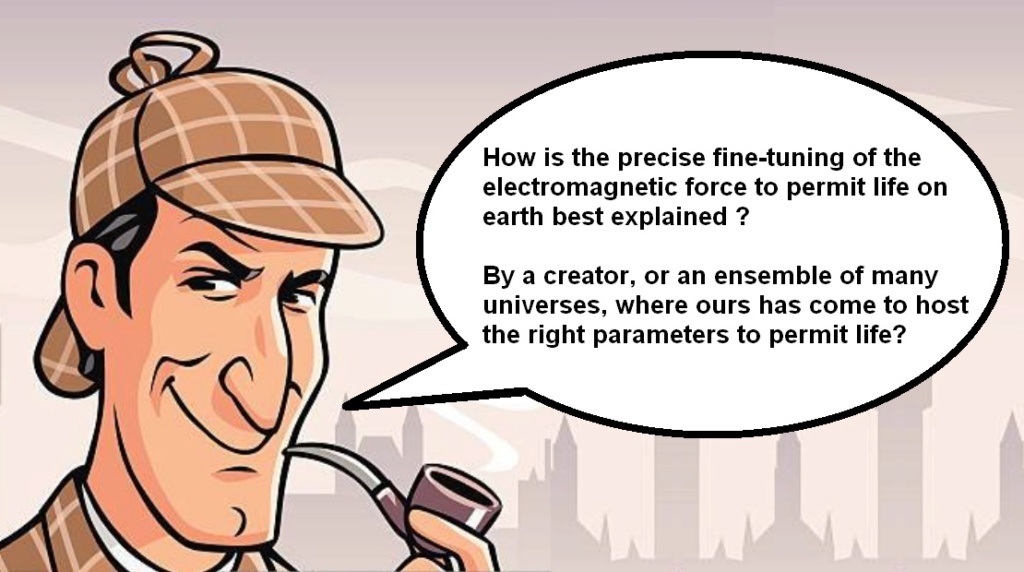
Why is the universe just right to host life? Why are the sixteen parameters of the electromagnetic force shown in this video just right, otherwise, if just one would have different values, we would not be here admiring these facts ?
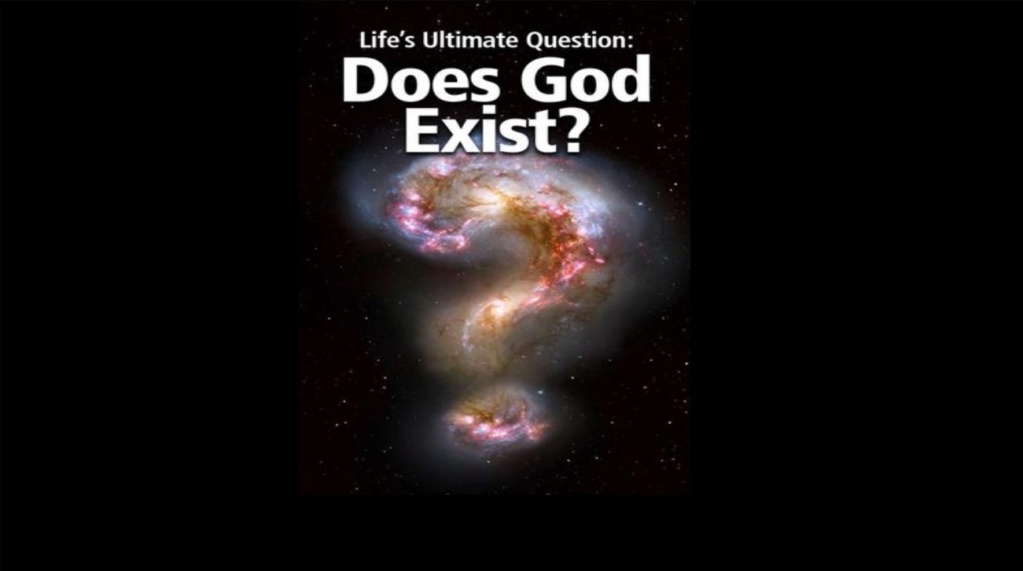
Does fine-tuning of the fundamental forces like the electromagnetic force evidence that God exists? What it demonstrates is that we live in a universe precisely tuned to permit life on earth; that if it wasn't in this VERY improbable way, we would not be here. What can we conclude? Is an alternative explanation to creation likely ? Is this just coming about by chance?
I hear most often atheists saying that there is no evidence of Gods existence. I think the fact that the universe and its fundamental forces and constants are finely adjusted, as the electromagnetic forces, to which we gave a closer look at this video, is overwhelming evidence that points to a special act of purposeful creation in order to host and make life possible on planet earth. Cosmologists that do not accept the God inference have not been able to bring up a better alternative than the multiverse hypothesis, which is entirely unscientific, and fraught with so many problems, I don't even know where to begin with.
The claim is that there is an almost infinite set of universes spreading and bubbling out from a universe-generator, each universe with different fundamental values, forces and constants, and amongst these, by chance, one emerging that is life-permitting, namely ours. One reason to reject the hypothesis is the fact that even such a universe generator would have had a beginning. And then we are back to ask, what caused that mechanism into being. We would just push the problem of the fundamental question, why there is something, rather than nothing, further back, without resolving the riddle.
Another often cited attempt of refutation is Douglas Addams puddle thinking. The claim is that it is not the universe that is tuned to host life, but we adapted to the conditions of the universe. The problem with this argument is that the starting conditions of the universe, and the Big Bang, also had to be precisely tuned. And that also demands an explanation.
Such amazing evidence permits an agnostic and people that are undecided to come closer to answer the most fundamental question of our existence. To me, any alternative explanation to creation brought up so far, like multiverses, is not compelling. Creation by an eternal powerful God seems clear to be the best inference and explanation.
As the apostle Paul wrote in his epistle to the Romans, chapter one, verses 19 to 23:
Since what may be known about God is plain to them, because God has made it plain to them. For since the creation of the world God’s invisible qualities—his eternal power and divine nature—have been clearly seen, being understood from what has been made, so that people are without excuse. For although they knew God, they neither glorified him as God nor gave thanks to him, but their thinking became futile and their foolish hearts were darkened. Although they claimed to be wise, they became fools.
Thank you for watching this video. If you enjoyed, please give a like, subscribe to my channel, discuss, or leave a message in the comments section.
Sources:
Is There Scientific Evidence for the Existence of God? How the Recent Discoveries Support a Designed Universe
http://www.leaderu.com/offices/bradley/docs/scievidence.html
J. C. Maxwell’s, ‘Dynamical theory of the electromagnetic field
https://makingscience.royalsociety.org/s/rs/items/PT_72_7/5f138c
Wonders of the Universe, Professor Brian Cox & Andrew Cohen, page 30
Christiaan Huygens
https://crev.info/scientists/christiaan-huygens/
Thomas young
https://www.johnsanidopoulos.com/2011/09/thomas-young-1773-1829-genius-with.html
https://crev.info/scientists/thomas-young/
André Marie Ampère: A Fascinating Genius and Devout Christian
http://blog.drwile.com/andre-marie-ampere-a-fascinating-genius-and-devout-christian/
Dimensionless physical constant
https://en.wikipedia.org/wiki/Dimensionless_physical_constant
Robert Boyle:
https://crev.info/scientists/robert-boyle/
The apparent fine-tuning of the cosmological, gravitational and fine structure constants
https://arxiv.org/ftp/arxiv/papers/1412/1412.7337.pdf
https://reasonandscience.catsboard.com/t2856-finetuning-of-the-electromagnetic-forces
Fine-tuning of the electromagnetic forces, evidence of design?
https://www.youtube.com/watch?v=BhwCazIoVC4
The electromagnetic force, one of the four fundamental forces of nature, must be finely tuned in at least sixteen different ways, in order for life in our universe, and on earth, to be possible.
1. If the electromagnetic force was stronger than it is, some of the chemicals essential for life, like carbon and oxygen, would not bond together and other life-essential elements would be too unstable for fission to occur. If the electromagnetic force were weaker than it is, chemicals could not bond properly and there would be insufficient carbon and oxygen to support life.
2. The electromagnetic force needs to be much weaker than the strong nuclear force for atoms to be stable – so that the radius of the electron orbit is much larger than the radius of the nucleus The wavelengths of radio waves can vary from about one millimeter to about 100 kilometers, so they cover quite a wide range.
3. The electromagnetic radiation range produced by the sun must be precisely tuned to the energies of the various chemical bonds on Earth. Excessively energetic photons of radiation destroy chemical bonds and destabilize organic molecules.
4. Ratio of electromagnetic and gravitational forces: The value of N in astronomy is the ratio of the strength of the electromagnetic force to the gravitational force. N has the value approximately equal to 10^40, which is 10,000,000,000,000,000,000,000,000,000,000,000,000,000
5. A precise number of electrons must exist in the universe. Unless the number of electrons is equivalent to the number of protons to at least an accuracy of one part in 10^37, electromagnetic forces in the universe would have to overcome gravitational forces that galaxies, stars, and planets never would have formed. One part in 10^37 is such an incredibly sensitive balance that it is hard to visualize.
6. Electromagnetic repulsion between protons prevents most of their collisions from resulting in proton-proton fusion, this explaining how stars can burn so slowly: each second our sun generates thousands of times less energy per gram than the human body. The strength of electromagnetism by comparison with gravity is crucial here.
7. Matching the radiation from the sun to the chemical bonding energy requires that the magnitude of six constants be selected and finely adjusted, guaranteeing that the photons are sufficiently energetic, but not too energetic.
8. Atmospheric Transmittance: This is a plot of Earth’s atmospheric transmittance (or opacity) to various wavelengths of electromagnetic radiation. Most UV wavelengths are absorbed by oxygen and ozone in Earth’s atmosphere. Absorption of light by either Earth's atmosphere or by water where the necessary chemical reactions occur could render life on Earth impossible.
9. Strangely enough, the electromagnetic radiation of the sun is restricted to a tiny region of the total electromagnetic spectrum, equivalent to one card in a deck of 10^25, and that the very same infinitely minute region is precisely that required for life. In addition, both the atmospheric gases and water are opaque to all regions of the spectrum except this same tiny region. Denton concludes: "it is as if a card player had drawn precisely the same card on four occasions from a deck of 10^25"
10. There's a unique, non-dimensional atomic constant in physics known as “alpha” or the “electromagnetic fine structure constant” which underpins the whole of nature, the form and structure of the whole universe. It is better known by its reciprocal number which is essentially equivalent to 1/137.
11. The Balance of the Strong and Electromagnetic Forces must be just right. These two are the strongest of the four fundamental forces. Yet they are pitted against each other in the tiny world of the nucleus.
12. Stars produce carbon and oxygen in comparable amounts. Astrophysicists have recently confirmed the sensitivity of carbon and oxygen production to the carbon-energy resonance;
13. The Electromagnetic force coupling constant Universes with ordered structures occupy a tiny region. The red section is the tiny window where carbon-based life is possible.
14. Without a finely tuned electromagnetic force coupling constant, stars would be unable to produce elements beyond helium. There would be no carbon, oxygen, nitrogen, etc, required for life.
15. When we look at this part of the light we see that a large part of solar radiation falling outside the range of visible light is in the section of the spectrum called "near-infrared".
16. And the third part of sunlight? Is that of any benefit? You can bet on it. This is "near-ultraviolet light" and it makes up the smallest fraction of sunlight.


Nobody in 1800 could have imagined that, within a hundred years or so, people would live in cities illuminated by electric light, work with machinery driven by electricity, in factories cooled by electric-powered refrigeration, and go home to listen to a radio and talk to neighbours on a telephone.
Remarkably, the scientists that made the milestone discoveries and advanced scientific knowledge in the field of electricity and electromagnetism were almost all devout Christians. They will be presented at this video, together with their inventions.

Everybody knows the practical use of electricity in modern life. The electromagnetic force underlying it belongs to the four fundamental forces

and must be finely tuned also in relation to other fundamental forces, to make a life-permitting universe possible. In this video, we will furthermore give a closer look at how the electromagnetic force must be finely tuned in various ways.

William Gilbert was the first man to research the properties of the lodestone (magnetic iron ore), publishing his findings in his influential book in 1600, 'De Magnete' ('The Magnet'). He actually coined the Latin word electricitas, which in English became electricity. He was besides Galileo the great pioneer of modern science.

The impact of Gilberts finding is eminent. He was one of the first modern scientists, also the accredited father of the science of electricity and magnetism, an Englishman of learning. In 1601, he was appointed as one of Queen Elizabeth’s personal physicians.

Gilbert's work was followed up by Robert Boyle, the famous natural philosopher who was once described as "father of Chemistry." Boyle was also one of the founders of the Royal Society. Boyle is known for his exceptional scientific work, that produced some fundamental discoveries.
He worked frequently at the new science of electricity and added several substances to Gilbert's list of electrics. He left a detailed account of his researches under the title of Experiments on the Origin of Electricity. He was a devout and pious Anglican and is noted for his writings in theology.

“What is light?” is a question that has intrigued scientists for centuries. In 1675, the famous English scientist Isaac Newton proposed that light was a stream of tiny particles. His rival, the Dutch physicist Christiaan Huygens, suggested that light consisted of waves, but Newton’s theories often dominated, partly due to Newton’s prestige.

Christiaan Huygens is today less known than Newton, nonetheless, he can be considered one of the greatest scientific geniuses of the 17th century, and if he lived today, he would be known as a promiment “intelligent design” promoter.
In the picture above is a quote from his book Cosmotheoros from 1698. If it were stated in modern English today, it would anger many origin-of-life researchers and evolutionary biologists. They would undoubtedly attribute it to one of the leaders of the intelligent design movement.
This was stated by the man who invented the pendulum clock, wrote the first book on probability, described the wave theory of light mathematically, belonged to the Royal Society and the French Academy of Sciences, accurately described Saturn’s rings as not touching the planet and discovered Saturn’s large moon Titan.
He also stood in the tradition seen so often in the scientists in this series that viewed scientific investigation as an honourable work undertaken “for the glory of God and the service of man.”

Around 1800, the English researcher Thomas Young—also famous for his work on deciphering the Rosetta Stone—began a series of experiments that provided support for Huygens’ wave theory.

In 1801,he made a famous double-slit experiment, which clearly showed that light diffracted, and therefore must travel in the form of a wave. Young used geometrical arguments to show that the superposition of light waves from the two slits explains the observed series of equally spaced bands (fringes) of light and dark regions, representing constructive and destructive interference, respectively.
Thomas Young was one of those rare individuals with such awesome intellectual powers it makes one marvel at the potential in one human brain. And if one thinks intelligence leads to skepticism, Young would disagree. He maintained his childlike faith and moral uprightness throughout his all-to-brief life of 56 years.

In 1800, William Herschel used a prism and a thermometer to measure the temperature of coloured light. He discovered that red light was warmer than violet light at the other end of the visible spectrum. He also noticed that there was measurable warmth beyond red light, even though no visible light was present. He had discovered the infra-red part of the electromagnetic spectrum.
William Herschel constructed over 400 telescopes, including the largest reflecting telescopes of his day, using them to catalog over 90,000 new stars, as well as nebulae and galaxies. After discovering Uranus, the 7th planet from the sun, King George III granted William Herschel a permanent salary as a royal astronomer. He believed in a divine Creator and Author of the laws of nature, to whom we owe our worship and admiration.

By 1825, French physicist André-Marie Ampère had established the foundation of electromagnetic theory. The connection between electricity and magnetism was largely unknown until 1820, when it was discovered that a compass needle moves when an electric current is switched on or off in a nearby wire.
Although not fully understood at the time, this simple demonstration suggested that electricity and magnetism were related phenomena, a finding that led to various applications of electromagnetism and eventually culminated in telegraphs, radios, TVs, and computers.
Subsequent experiments during a period from 1820 to 1825 by Ampère and others showed that any conductor that carries an electric current and produces a magnetic field around it. This basic finding and its various consequences for conducting wires is sometimes referred to as Ampère’s Law of Electromagnetism.
Maxwell wrote about Ampère's achievements:
The experimental investigation by which Ampere established the law of the mechanical action between electric currents is one of the most brilliant achievements in science. The whole theory and experiment seems as if it had leaped, full grown and full armed, from the brain of the 'Newton of Electricity'.
It is perfect in form, and unassailable in accuracy, and it is summed up in a formula from which all the phenomena may be deduced, and which must always remain the cardinal formula of electro-dynamics.
In 1804, Ampère helped to form a group called the Société Chrétienne (Christian Society). Each member was a scholar, and each was given the task of producing a statement about the Christian faith. Ampère was tasked with writing about rational evidence that supports Christianity. According to his biographer, he wrote:

All modes of proof combine in favour of Christianity. To see the truth, the metaphysician needs only to examine the manner in which the divine religion simultaneously explains the grandeur and the baseness of man, and the idea it gives us of the relations of God with his creatures and of the intentions of Providence.

In 1831, Michael Faraday discovered electromagnetic induction, which was his greatest contribution to science. He noticed that when he moved a magnet through a stationary coil of wire, he always produced an electric current in the wire.

Faraday believed that God sustained the universe and that he was doing God’s will to reveal truth through careful experiments and through his colleagues, who tested and built upon his results.

He accepted every word of the Bible as literal truth, but meticulous experiments were essential in this world before any other kind of assertion could be accepted.

James Clerk Maxwell developed in a series of papers in 1861 and 1862 a single theory of electricity and magnetism that was able to explain all of the experimental work of Faraday, Ampère and others.

But Maxwell’s crowning glory came in 1864 when he published a paper that is undoubtedly one of the greatest achievements in the history of science. The speed of the waves is the ratio of the strengths of the electric and magnetic fields – quantities that had been measured by Faraday, Ampère, and others and were well known to Maxwell.
His calculations unravelled that light is composed of electromagnetic waves, a theory that was proved to be correct by H. Hertz in 1887, who also detected electromagnetic waves with very long wavelengths and thus added the radio band to the electromagnetic spectrum.

When Maxwell did the sums, he must have fallen off his chair. He found that his equations predicted that the waves in the electric and magnetic fields traveled at the speed of light! Maxwell's equations for electromagnetism have been called the "second great unification in physics" after the first one realised by Isaac Newton.


In other words, Maxwell had discovered that light is nothing more than oscillating electric and magnetic fields, sloshing back and forth and propelling each other through space as they do so. How beautiful that the work of Faraday, Ampère, and others with coils of wire and pieces of magnets could lead to such a profound conclusion through the use of a bit of mathematics and a sprinkling of Scottish genius! In modern language, we would say that light is an electromagnetic wave.
Albert Einstein later described Maxwell’s 1860s papers as ‘the most profound and the most fruitful that physics has experienced since the time of Newton.’ Maxwell discovered that by unifying electrical and magnetic phenomena together into a single mathematical theory, a startling prediction emerges. Electricity and magnetism can be unified by introducing two new concepts: electric and magnetic fields.

The concept of a field is central to modern physics; the temperature in a room can be represented as a field. If we measure the temperature at each point in the room and note it down, we would have a vast array of numbers that described how the temperature changes from the door to the windows and from the floor to the ceiling.

In a similar way, we can use the concept of a magnetic field by holding a compass at places around a wire carrying an electric current and noting down how much the needle changes its direction. The numbers and directions are the magnetic fields. Maxwell discovered that by introducing the electric and magnetic fields and placing them centre stage, he was able to write down a single set of equations that described all the known electrical and magnetic phenomena.
He mathematically disproved the nebular hypothesis proposed in 1796 by French atheist, Laplace, which suggested that the solar system began as a cloud of gas which contracted to produce stars and planets. Maxwell also strongly opposed Darwin’s theory of evolution, which was becoming popular at that time.
He believed that the speculations involved in evolutionary thinking contradicted scientific evidence. Maxwell was convinced that scientific investigation and the teachings of the Bible were not only compatible but should be linked together.

In another milestone in 1895, Wilhelm Conrad Röntgen was the first person to systematically produce and detect electromagnetic radiation in a wavelength range today known as x-rays. He produced and detected electromagnetic radiation, an achievement that earned him the first Nobel Prize in Physics in 1901. Max von Laue finally demonstrated that these X-rays are electromagnetic waves of extremely short wavelengths.
By then the wavelength range of the electromagnetic spectrum spanned from about 1 nanometer to 100 meters.

Röntgen was conducting experiments with electrical discharges in evacuated glass tubes. One night, he noticed a glow which was not caused by fluorescence or visible light. He named this discovery "X." When he immobilised for some moments in one of his experiments the hand of his wife in the path of the rays over a photographic plate, he observed after development of the plate an image of his wife’s hand. This was the first “röntgenogram” ever taken.

Wilhelm Conrad Röntgen and his father were members of the Dutch Reformed Church, the mainstream Protestant congregation in the Netherlands, also the religion of the Dutch royal family. Röntgen’s mother, however, belonged to the much smaller Wallonian Protestant Church which since 1815 is a division of the Dutch Reformed Church. French was the language of their worship services.

The induction motor is one of the most important inventions in modern history. It turned the wheels of progress at a new speed and officially kicked off the second industrial revolution by drastically improving energy generation efficiency and making the long-distance distribution of electricity possible.

Today, not only do the machines turn on the lights in your home but also power many mechanical gadgets people take for granted, from vacuum cleaners and electric toothbrushes to that classy Tesla Motors Model S.
The electromagnetic spectrum, fine-tuned for life

Electrons are held in their orbit by the electromagnetic force. Electrons have a negative electric charge and are therefore attracted to the protons which have a positive electric charge.
The two fundamental forces of gravity and electromagnetism need to be balanced on razor'srs edge, and the radiation of the sun has to be finely tuned to permit life on earth.

The electromagnetic force is responsible for holding electrons in their orbit around the nucleus of an atom. These electrons interact with other electrons to form electron bonds among elements and produce molecules and, eventually, visible matter. Electrons give atoms the ability to link to each other to form bonds which create molecules, which are the building blocks of matter.
Without these bonds, matter would cease to exist beyond the atomic level.
Imagine a Universe Creating Machine with numerous dials, each of which sets the value of a fundamental law, constant, or initial condition. Only if each of the dials is set to the right combination will the machine produce a habitable universe. Most of the settings produce uninhabitable universes.
1. If the electromagnetic force was stronger than it is, some of the chemicals essential for life, like carbon and oxygen, would not bond together and other life-essential elements would be too unstable for fission to occur. If the electromagnetic force were weaker than it is, chemicals could not bond properly and there would be insufficient carbon and oxygen to support life.
2. The electromagnetic force needs to be much weaker than the strong nuclear force for atoms to be stable – so that the radius of the electron orbit is much larger than the radius of the nucleus The wavelengths of radio waves can vary from about one millimeter to about 100 kilometers, so they cover quite a wide range.

At the beginning of the twentieth century Max Planck and Albert Einstein, two Nobel Prize winners, carried out the epoch-making studies proving that light has a dual nature.

It can be regarded as an electromagnetic wave as well as an emission of particles, which are termed light quanta or photons. Light has properties of waves.


The electromagnetic spectrum refers to the vast range of frequencies of electromagnetic radiation. It is composed of waves of energy that can propagate through a vacuum and that contain electric and magnetic field components that oscillate perpendicular to each other. Different portions of the spectrum are identified according to the frequency of the waves.
In order of increasing frequency (and decreasing wavelength), we have radio waves, microwaves, infrared radiation, visible light, ultraviolet radiation, Xrays, and gamma rays. A specific "colour" of light has a characteristic wavelength. The distance between peaks in a wave is referred to as the wavelength and is abbreviated with the Greek letter lambda.

The longer the wavelength, the less energy it carries. The shorter the wavelength the more energy is associated with that band of the electromagnetic spectrum.

3. The electromagnetic radiation range produced by the sun must be precisely tuned to the energies of the various chemical bonds on Earth. Excessively energetic photons of radiation destroy chemical bonds and destabilize organic molecules.
Insufficiently energetic photons would result in chemical reactions that are either too sluggish or would not occur at all. All life on Earth depends upon fine-tuned solar radiation, which requires, in turn, a very precise balancing of the electromagnetic and gravitational forces.
Happily, our star (the sun) emits radiation (light) that is finely tuned to drive the chemical reactions necessary for life. But there is still a critical potential problem: getting that radiation from the sun to the place where the chemical reactions occur. Passing through the near vacuum of space is no problem.

John A. Leslie: A star’s surface temperature must be suitably related to the binding energies of chemical reactions used by organisms: it must be hot enough to encourage construction of new chemicals, as in photosynthesis, but also cool enough to limit destruction such as is produced by ultraviolet light.

4. Ratio of electromagnetic and gravitational forces: The value of N in astronomy is the ratio of the strength of the electromagnetic force to the gravitational force. N has the value approximately equal to 10^40, which is 10,000,000,000,000,000,000,000,000,000,000,000,000,000
The force of gravity is a thousand million billion billion billion times weaker than the electromagnetic force. To guard against any one disaster by tinkering with these or those factors would be likely only to introduce some new disaster because each factor enters into so many vital relationships.
If the electromagnetic force were to be even slightly stronger relative to all the other fundamental forces, all stars would be red dwarfs, and planets would not form. Or if it were a little weaker, all stars would be very hot, and thus short-lived.
Gravity as one of these forces also needs fine tuning for stars and planets to form, and for stars to burn stably over billions of years. Gravity is roughly 10^39 times weaker than electromagnetism. Had it been only 10^33 times weaker, stars would be a billion times less massive and would burn a million times faster.

5. A precise number of electrons must exist in the universe. Unless the number of electrons is equivalent to the number of protons to at least an accuracy of one part in 10^37, electromagnetic forces in the universe would have to overcome
gravitational forces that galaxies, stars, and planets never would have formed. One part in 10^37 is such an incredibly sensitive balance that it is hard to visualize. The following analogy given by Hugh Ross might help:
Cover the entire North American continent in dimes all the way up to the moon, a height of about 239,000 miles. (In comparison, the money to pay for the U.S. federal government debt would cover one square mile less than two feet deep with dimes.) Next, pile dimes from here to the moon on a million other continents the same size as North America.
Paint one dime red and mix it into the billion piles of dimes. Blindfold a friend and ask him to pick out one dime. The odds that he will pick the red dime are one in 10^37. And this is only one of the parameters that is so delicately balanced to allow life to form.
6. Electromagnetic repulsion between protons prevents most of their collisions from resulting in proton-proton fusion, this explaining how stars can burn so slowly: each second our sun generates thousands of times less energy per
gram than the human body. The strength of electromagnetism by comparison with gravity is crucial here.

7. Matching the radiation from the sun to the chemical bonding energy requires that the magnitude of six constants be selected and finely adjusted, guaranteeing that the photons are sufficiently energetic, but not too energetic.
In what is either an amazing coincidence or careful design by an intelligent Creator, these constants have the very precise values relative to each other that are necessary to give a universe in which radiation from the sun is tuned to the necessary chemical reactions that are essential for life. The greatest intensity of radiation from the sun occurs at the place of greatest biological utility.

8. Atmospheric Transmittance: This is a plot of Earth’s atmospheric transmittance (or opacity) to various wavelengths of electromagnetic radiation. Most UV wavelengths are absorbed by oxygen and ozone in Earth’s atmosphere. Absorption of light by either Earth's atmosphere or by water where the necessary chemical reactions occur could render life on Earth impossible.
It is remarkable that both the Earth's atmosphere and water have "optical windows" that allow visible light (just the radiation necessary for life) to pass through with very little absorption, whereas shorter wavelength (destructive ultraviolet radiation) and longer wavelength (infrared) radiation are both highly absorbed
It is remarkable that the optical properties of water and our atmosphere, the chemical bonding energies of the chemicals of life, and the radiation from the sun are all precisely harmonized to allow living systems to utilize the energy from the sun, without which life could not exist.
The British physicist Ian Campbell addresses this question and says "That the radiation from the Sun (and from many sequence stars) should be concentrated into a minuscule band of the electromagnetic spectrum which provides precisely the radiation required to maintain life on earth is very remarkable." According to Campbell, this situation is "staggering".

9. Nearly all of the Sun's radiation is restricted to a narrow band of wavelengths ranging from 0.3 to 1.50 microns. This band encompasses near ultraviolet, visible, and infrared light. In the whole electromagnetic spectrum, there is just one little band that has the energy to cross this threshold exactly. Its wavelengths range between 0.70 microns and 0.40 microns and if you'd like to see it, you can: just raise your head and look around–it's called "visible light".
This radiation causes chemical reactions to take place in your eyes and that is why you are able to see. Visible light covers the range of wavelengths from 400 - 700 nm. Our sun emits most of its radiation in the visible range, which our eyes perceive as the colours of the rainbow. Our eyes are sensitive only to this small portion of the electromagnetic spectrum.
Some wavelengths are several kilometers long while others are shorter than a billionth of a centimeter and the other wavelengths are to be found in a smooth, unbroken spectrum everywhere in between. To make things easier, scientists divide this spectrum up according to wavelength and they assign different names to different parts of it. The radiation with the shortest wavelength (one-trillionth of a centimeter) for example is called "gamma rays": these rays pack tremendous amounts of energy. The longest wavelengths are called "radio waves": they can be several kilometers long but carry very little energy.
Strangely enough, the electromagnetic radiation of the sun is restricted to a tiny region of the total electromagnetic spectrum, equivalent to one card in a deck of 10^25, and that the very same infinitely minute region is precisely that required for life. In addition, both the atmospheric gases and water are opaque to all regions of the spectrum except this same tiny region. Denton concludes: "it is as if a card player had drawn precisely the same card on four occasions from a deck of 10^25"

The number of electrons to protons must be finely balanced to a degree of one part in 10^37. If this fundamental constant were to be any larger or smaller than this, the electromagnetism would dominate gravity -- preventing the formation of galaxies, stars and planets. Again, life would not be possible.

The ratio of the electromagnetic force to gravity must be finely balanced to a degree of one part in 10^40. If this value were to be increased slightly, all stars would be at least 40% more massive than our Sun. This would mean that stellar burning would be too brief and too uneven to support complex life. If this value were to be decreased slightly, all stars would be at least 20% less massive than the sun. This would render them incapable of producing heavy elements.

10. There's a unique, non-dimensional atomic constant in physics known as “alpha” or the “electromagnetic fine structure constant” which underpins the whole of nature, the form and structure of the whole universe. It is better known by its reciprocal number which is essentially equivalent to 1/137.

It is related to the probability of electrons or other charged particles absorbing or emitting photons and is the ratio of the strength of electromagnetism compared to the strong nuclear force. Increasing it to above 1/85 (from its present 1/137) could result in too many proton decays for there to be long-lived stars, let alone living beings who were not killed by their own radioactivity.
The number is required to know how specific wavelengths of light interact in precise ways with atoms and how electromagnetic forces hold atoms together. Hence we know that this number is one of the core factors that determine the size of the atoms.

The fine-structure constant controls how strong chemical bonds are, how we see light and the vast majority of the things in the world. It also controls fusion in stars, which is important as that’s how all the chemical elements are created. It governs—among other things—the energy levels of an atom formed from negatively charged electrons and a positive nucleus.

American theoretical physicist Feynman once commented on the famous value of the fine structure constant alpha :

“There is a most profound and beautiful question associated with the observed coupling constant, e—the amplitude for a real electron to emit or absorb a real photon . . . It’s one of the greatest damn mysteries of physics: a magic number that comes to us with no understanding by man. You might say the ‘hand of God’ wrote that number, and ‘we don’t know how He pushed his pencil’.
J.D.Barrow and F.J.Tipler remark that in any case the difference between material things and waves is maintained only thanks to the smallness of the electromagnetic fine structure constant: it has to be a small fraction—it is about 1/137—to ensure ‘the distinguishability of matter and radiation’, for reasons centred on how an electron might be thought of as spending that same fraction of its time ‘as an electromagnetic wave’. Had the fraction been much larger, atomic and molecular states would be very unstable.

11. The Balance of the Strong and Electromagnetic Forces must be just right. These two are the strongest of the four fundamental forces. Yet they are pitted against each other in the tiny world of the nucleus. The balance in atomic nuclei between strong-force attraction and the electromagnetic repulsion which nearly blows apart any atom with two protons or more must be precisely tuned.
Together with the Pauli principle, the small mass of the electron, the fact that electrons do not feel the strong force, this balance allows for a hundred or so markedly different kinds of atom: building-bricks whose electrons make them more useful than the solid spheres imagined by an early physics.
12. Stars produce carbon and oxygen in comparable amounts. Astrophysicists have recently confirmed the sensitivity of carbon and oxygen production to the carbon-energy resonance; a change in the (strong) nuclear force strength (the force that binds particles in an atomic nucleus) by more than about half a percent, or by 4 percent in the electromagnetic force (the force between charged particles), would yield a universe with either too much carbon compared with oxygen or vice versa, and thus little if any chance for life.

13. The Electromagnetic force coupling constant Universes with ordered structures occupy a tiny region. The red section is the tiny window where carbon-based life is possible. We can see, how the electromagnetic force, more precisely, the electromagnetic coupling constant, also called the fine structure constant, plays a decisive role.

14. Without a finely tuned electromagnetic force coupling constant, stars would be unable to produce elements beyond helium. There would be no carbon, oxygen, nitrogen, etc, required for life.
Furthermore, the electromagnetic coupling constant binds electrons to protons in atoms. If it was smaller, fewer electrons could be held. If it was larger, electrons would be held too tightly to bond with other atoms.

15. When we look at this part of the light we see that a large part of solar radiation falling outside the range of visible light is in the section of the spectrum called "near infrared". This begins where visible light ends and again occupies a very small part of the total spectrum–less than 1/10^25 Is infrared light good for anything?
Yes, but this time it's no use to look around because you can't see it with the naked eye. However, you can easily feel it: the warmth you feel on your face when you look up on a bright sunny summer or spring day is caused by infrared radiation coming from the Sun. The Sun's infrared radiation is what carries the thermal energy that keeps Earth warm.
It too is as essential for life as visible light is. And the fascinating thing is that our Sun was apparently created just to serve for these two purposes because these two kinds of light make up the greatest part of sunlight.
16. And the third part of sunlight? Is that of any benefit? You can bet on it. This is "near ultraviolet light" and it makes up the smallest fraction of sunlight. Like all ultraviolet light, it is highly energized and it can cause damage to living cells. The Sun's ultraviolet light, however, is the "least harmful" kind since it is closest to visible light.
Although overexposure to solar ultraviolet light has been shown to cause cancer and cellular mutations, it has one vital benefit: the ultraviolet light concentrated in such a minuscule band is needed for the synthesis of vitamin D in humans and other vertebrates.
(Vitamin D is necessary for the formation and nourishment of bone: without it, bones become soft or malformed, a disease called rickets that occurs in people deprived of sunlight for great lengths of time.) In other words, all the radiation emitted by the Sun is essential to life: none of it is wasted.
The amazing thing is that all this radiation is limited to a 1/10^25 interval of the whole electromagnetic spectrum yet it is sufficient to keep us warm, see, and allow all the chemical reactions necessary for life to take place. Even if all the other conditions necessary for life, if the light radiated by the Sun fell into any other part of the electromagnetic spectrum, there could be no life on Earth.
It is certainly impossible to explain the fulfilment of this condition having a probability of 1 in 10^25 with a logic of coincidence. And if all this were not enough, light does something else: it keeps us fed, too!

The Christian doctrine of creation gave the impetus to scientific discovery in Western Christendom in the first place because it said that the universe was freely created by God as totally distinct from God, and is therefore contingent. It is also very interesting to point out that even though Christianity has an incredible track record of being very conducive for scientific progress, higher education, and also being very helpful to the education of children in grade-school, Christianity is, in spite of its unmatched track record in education and scientific progress, treated with severe prejudice in higher education in many parts of the world today.

Almost all these great men, some which won the Nobel prize for their achievements, were creationists and scientists of the highest rank and intelligence, and largely responsible for the conveniences we enjoy today including internet, cell phones, television, radio, calculus, and on and on it goes. And yet atheist fanatics are all running around slandering and arguing that science and religion are in opposition.

Norman Geisler:
The creation-evolution debate is not religion versus science or the Bible versus science, it's about good science versus bad science. Likewise, it's not faith versus reason, its about reasonable faith, versus unreasonable faith.

In this video, 16 different ways of how the electromagnetic force has to be finely tuned have been listed. This is intriguing and awe-inspiring evidence that demands an explanation.

Why is the universe just right to host life? Why are the sixteen parameters of the electromagnetic force shown in this video just right, otherwise, if just one would have different values, we would not be here admiring these facts ?

Does fine-tuning of the fundamental forces like the electromagnetic force evidence that God exists? What it demonstrates is that we live in a universe precisely tuned to permit life on earth; that if it wasn't in this VERY improbable way, we would not be here. What can we conclude? Is an alternative explanation to creation likely ? Is this just coming about by chance?
I hear most often atheists saying that there is no evidence of Gods existence. I think the fact that the universe and its fundamental forces and constants are finely adjusted, as the electromagnetic forces, to which we gave a closer look at this video, is overwhelming evidence that points to a special act of purposeful creation in order to host and make life possible on planet earth. Cosmologists that do not accept the God inference have not been able to bring up a better alternative than the multiverse hypothesis, which is entirely unscientific, and fraught with so many problems, I don't even know where to begin with.
The claim is that there is an almost infinite set of universes spreading and bubbling out from a universe-generator, each universe with different fundamental values, forces and constants, and amongst these, by chance, one emerging that is life-permitting, namely ours. One reason to reject the hypothesis is the fact that even such a universe generator would have had a beginning. And then we are back to ask, what caused that mechanism into being. We would just push the problem of the fundamental question, why there is something, rather than nothing, further back, without resolving the riddle.
Another often cited attempt of refutation is Douglas Addams puddle thinking. The claim is that it is not the universe that is tuned to host life, but we adapted to the conditions of the universe. The problem with this argument is that the starting conditions of the universe, and the Big Bang, also had to be precisely tuned. And that also demands an explanation.
Such amazing evidence permits an agnostic and people that are undecided to come closer to answer the most fundamental question of our existence. To me, any alternative explanation to creation brought up so far, like multiverses, is not compelling. Creation by an eternal powerful God seems clear to be the best inference and explanation.
As the apostle Paul wrote in his epistle to the Romans, chapter one, verses 19 to 23:
Since what may be known about God is plain to them, because God has made it plain to them. For since the creation of the world God’s invisible qualities—his eternal power and divine nature—have been clearly seen, being understood from what has been made, so that people are without excuse. For although they knew God, they neither glorified him as God nor gave thanks to him, but their thinking became futile and their foolish hearts were darkened. Although they claimed to be wise, they became fools.
Thank you for watching this video. If you enjoyed, please give a like, subscribe to my channel, discuss, or leave a message in the comments section.
Sources:
Is There Scientific Evidence for the Existence of God? How the Recent Discoveries Support a Designed Universe
http://www.leaderu.com/offices/bradley/docs/scievidence.html
J. C. Maxwell’s, ‘Dynamical theory of the electromagnetic field
https://makingscience.royalsociety.org/s/rs/items/PT_72_7/5f138c
Wonders of the Universe, Professor Brian Cox & Andrew Cohen, page 30
Christiaan Huygens
https://crev.info/scientists/christiaan-huygens/
Thomas young
https://www.johnsanidopoulos.com/2011/09/thomas-young-1773-1829-genius-with.html
https://crev.info/scientists/thomas-young/
André Marie Ampère: A Fascinating Genius and Devout Christian
http://blog.drwile.com/andre-marie-ampere-a-fascinating-genius-and-devout-christian/
Dimensionless physical constant
https://en.wikipedia.org/wiki/Dimensionless_physical_constant
Robert Boyle:
https://crev.info/scientists/robert-boyle/
The apparent fine-tuning of the cosmological, gravitational and fine structure constants
https://arxiv.org/ftp/arxiv/papers/1412/1412.7337.pdf
Last edited by Admin on Mon Apr 06, 2020 9:36 am; edited 1 time in total

